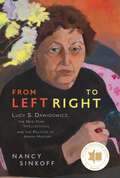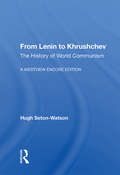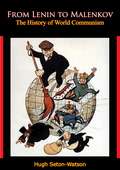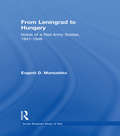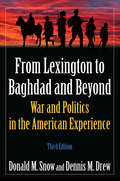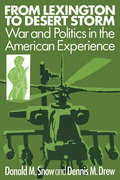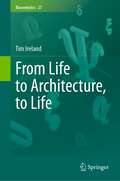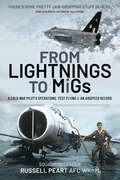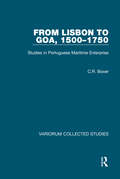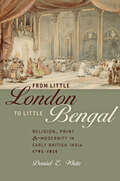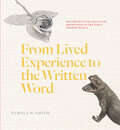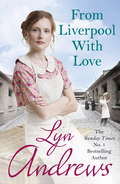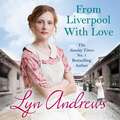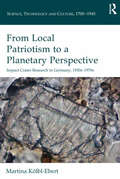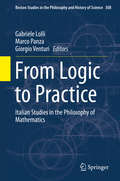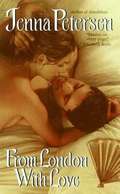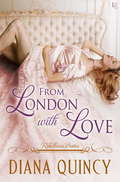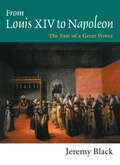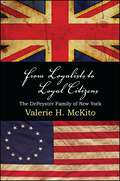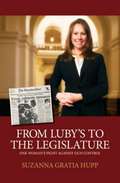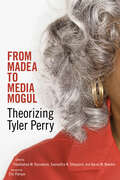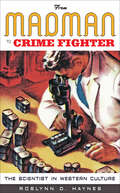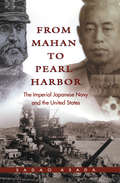- Table View
- List View
From Left to Right: Lucy S. Dawidowicz, the New York Intellectuals, and the Politics of Jewish History
by Nancy SinkoffFrom Left to Right: Lucy S. Dawidowicz, the New York Intellectuals, and the Politics of Jewish History is the first comprehensive biography of Dawidowicz (1915–1990), a pioneer historian in the field that is now called Holocaust studies. Dawidowicz was a household name in the postwar years, not only because of her scholarship but also due to her political views. Dawidowicz, like many other New York intellectuals, was a youthful communist, became an FDR democrat midcentury, and later championed neoconservatism. Nancy Sinkoff argues that Dawidowicz’s rightward shift emerged out of living in prewar Poland, watching the Holocaust unfold from New York City, and working with displaced persons in postwar Germany. Based on over forty-five archival collections, From Left to Right chronicles Dawidowicz’s life as a window into the major events and issues of twentieth-century Jewish life. From Left to Right is structured in four parts. Part 1 tells the story of Dawidowicz’s childhood, adolescence, and college years when she was an immigrant daughter living in New York City. Part 2 narrates Dawidowicz’s formative European years in Poland, New York City (when she was enclosed in the European-like world of the New York YIVO), and Germany. Part 3 tells how Dawidowicz became an American while Polish Jewish civilization was still inscribed in her heart and also explores when and how Dawidowicz became the voice of East European Jewry for the American Jewish public. Part 4 exposes the fissure between Dawidowicz’s European-inflected diaspora nationalist modern Jewish identity and the shifting definition of American liberalism from the late 1960s forward, which also saw the emergence of neoconservatism. The book includes an interpretation of her memoir From that Place and Time, as well as an appendix of thirty-one previously unpublished letters that illustrate the broad reach of her work and person. Dawidowicz’s right-wing politics, sex, and unabashed commitment to Jewish particularism in an East European Jewish key have resulted in scholarly neglect. Therefore, this book is strongly recommended for scholars and general readers interested in Jewish and women’s studies.
From Lenin To Khrushchev: The History Of World Communism
by Hugh Seton-WatsonThis book is intended to be both less and more than a survey of communism in the world today or a history of communist movements. It focuses on the relationship of communist movements to social classes and to the internal balance of political power in their respective countries.
From Lenin to Malenkov: The History of World Communism
by Hugh Seton-WatsonThis comparative analysis of various communist movements across the globe from eminent British historian and political scientist, Hugh Seton-Watson, delves deeply into the social and political states of countries where communists attempted to seize—and successfully seized—power. The author of many of the mid-20th century’s standard works on Russian and Eastern European history, Seton-Watson’s 1953 study carefully follows the sequence of communist revolution: from the Marxist-Leninist seizure of power in Russia during WWI and its consolidation under Lenin; the rise and horrors of Stalinism in the late 20s, 30s and 40s; the birth of the Comintern and popular front in the inter-war period; the communist inspired/directed resistance movements of the war years; through to the Stalinisation of Eastern Europe in the wake of WWII; the rise and triumph of Mao in China; communist triumphs in Korea and Southeast Asia; and the role of Marxist-Leninist and Stalinist thought in the nationalist/anti-colonialist movements in Africa, Asia and Latin America in the early-mid-20th century.An unmissable addition to your collection!“Both the subject and the literature of communism are vast. Communism is a theory, which professes to explain philosophy, religion, history, economics and society. Communism is a vocation, whose devotees accept its discipline in every part of their private and professional lives. Communism is a science of conspiracy, a technique of wrecking and subversion. Communism is a revolutionary movement, a political force which operates in a social environment, which recruits its members from various classes of society, and marshals its armies against various political opponents.”—Hugh Seton-Watson, Introduction
From Leningrad to Hungary: Notes of a Red Army Soldier, 1941-1946 (Soviet (russian) Study Of War Ser.)
by Evgenii D. MoniushkoThis new book is a chronological narrative of the experiences of Evgenii Moniushko, who lived through and survived the first year of the siege of Leningrad and who served as a junior officer in the Red Army during the last eighteen months of war and the first year of the Soviet occupation of Czechoslovakia and Hungary. This volume presents&nbs
From Lexington to Baghdad and Beyond: War and Politics in the American Experience
by Donald M Snow Dennis M. DrewDecisions about when, where, and why to commit the United States to the use of force, and how to conduct warfare and ultimately end it, are hotly debated not only contemporaneously but also for decades afterward. We are engaged in such a debate today, quite often without a solid grounding in the country's experience of war, both political and military. This book, by a political scientist and a career military officer and historian, is premised on the view that we cannot afford that kind of innocence. Updated and revised with new chapters on the Afghan and Iraq wars, the book systematically examines twelve U.S. wars from the revolution to the present day. For each conflict the authors review underlying issues and events; political objectives; military objectives and strategy; political considerations; military technology and technique; military conduct, and 'the better state of the peace', that is, the ultimate disposition of the original political goals.
From Lexington to Desert Storm: War and Politics in the American Experience
by Donald M Snow Dennis M. DrewFirst Published in 2015. Routledge is an imprint of Taylor & Francis, an Informa company.
From Life to Architecture, to Life (Biosemiotics #27)
by Tim IrelandThe book establishes a correlation between architectural theory and the biosemiotic project, and suggest how this coupling establishes a framework leading to an architectural-biosemiotic paradigm that puts biosemiotic theory at the heart of cognising the built environment, and offers an approach to understanding and shaping the built environment that supports (and benefits) human, and organismic, spatial intelligence.
From Light to Byte: Toward an Ethics of Digital Cinema
by Markos HadjioannouCinema has been undergoing a profound technological shift: celluloid film is being replaced by digital media in the production, distribution, and reception of moving images. Concerned with the debate surrounding digital cinema&’s ontology and the interrelationship between cinema cultures, From Light to Byte investigates the very idea of change as it is expressed in the current technological transition. Markos Hadjioannou asks what is different in the way digital movies depict the world and engage with the individual and how we might best address the issue of technological shift within media archaeologies.Hadjioannou turns to the technical basis of the image as his first point of departure, considering the creative and perceptual activities of moviemakers and viewers. Grounded in film history, film theory, and philosophy, he explores how the digital configures its engagement with reality and the individual while simultaneously replaying and destabilizing celluloid&’s own structures. He observes that, where film&’s photographic foundation encourages an existential association between individual and reality, digital representations are graphic renditions of mathematical codes whose causal relations are more difficult to trace.Throughout this work Hadjioannou examines how the two technologies set themselves up with reference to reality, physicality, spatiality, and temporality, and he concludes that the question concerning digital cinema is ultimately one of ethical implications—a question, that is, of the individual&’s ability to respond to the image of the world.
From Lightnings to MiGs: A Cold War Pilot's Operations, Test Flying & an Airspeed Record
by Russ PeartIt was supposed to be just a training flight. The two Soviet-manufactured MiG 21s, each with two practice bombs and four air-to-ground rockets, were lined up on the runway in Bangladesh at the height of the Cold War, when air traffic control suddenly reported an incursion by Indian Air Force Jaguars. Though ill-equipped for combat, the two MiGs were scrambled. One of the MiGs’ pilots was an RAF officer – Squadron Leader Russell Peart. On a seven-month loan to the Bangladeshi Air Force, Peart suddenly found himself at the centre of the simmering hostility between two neighbouring nations. By the time they reached the area that had been threatened by the Indian pilots, the Jaguars had gone. Later, when Squadron Leader Russell Peart spoke of the incident to the British High Commissioner, he was told not to shoot down any Jaguars as the Indians had still not paid for them! Russell Peart flew many other aircraft in his varied career, including the MiG 19, and while a test pilot at Boscombe Down trialled such designs as the Tornado GR1. But it was whilst he was seconded to the Sultan of Oman’s Air Force, particularly during the so-called ‘Secret War’ in Dhofar, that he saw the most action. In that theatre the author flew some 200 operational sorties, 180 of which involved live fire, during which he was hit many times. He was also hit and wounded by a 75mm shell. Russ Peart has written in detail of his exciting RAF career, from flying Lightnings in the Far East to winning the top prize in the International Tactical Bombing Competition against a handpicked team of United States Air Force fighter pilots and being awarded the Sultan Of Oman’s Distinguished Service Medal. Supplemented by a selection of previously unseen photographs, this uniquely original memoir throws new light on the operational flying undertaken by some RAF pilots during the tense years of the Cold War.
From Lisbon to Goa, 1500-1750: Studies in Portuguese Maritime Enterprise (Variorum Collected Studies)
by C.R. BoxerThese articles deal with the functioning, and malfunctioning, of the Carreira da India, the round voyages made between Portugal and its possessions in India that began after Vasco da Gama had opened up the route round the Cape of Good Hope in 1497-99. On such voyages was the Portuguese colonial empire built, and these studies illustrate the conditions under which they operated - the ships, the crews, their navigation and their cargoes. For instance, details are given of the medicines carried on board and the hospital established at the way-station of Moçambique in an attempt to combat the perennial scourge of disease. The principal hazard, however, remained that of loss through shipwreck or enemy action, events all too common in the history of the Carreira, which are brought to life most vividly in the Portuguese literary classic, the História Trágico-MarÃtima; the early printed editions of such tales form the subject of two of the articles and the backdrop to much of the volume.
From Little London to Little Bengal: Religion, Print, and Modernity in Early British India, 1793–1835
by Daniel E. WhiteHow literary and religious traffic between Bengal and Britain in the late 18th and early 19th centuries impelled a complex and contested cosmopolitan imperial culture.From Little London to Little Bengal traces the traffic in culture between Britain and India during the Romantic period. To some, Calcutta appeared to be a "Little London," while in London itself an Indianized community of returned expatriates was emerging as "Little Bengal." Circling between the two, this study reads British and Indian literary, religious, and historical sources alongside newspapers, panoramas, religious festivals, idols, and museum exhibitions. Together and apart, Britons and Bengalis waged a transcultural agon under the dynamic conditions of early nineteenth-century imperialism, struggling to claim cosmopolitan perspectives and, in the process, to define modernity.Daniel E. White shows how an ambivalent Protestant contact with Hindu devotion shaped understandings of the imperial mission for Britons and Indians during the period. Investigating global metaphors of circulation and mobility, communication and exchange, commerce and conquest, he follows the movements of people, ideas, books, art, and artifacts initiated by writers, publishers, educators, missionaries, travelers, and reformers. Along the way, he places luminaries like Romantic poet Robert Southey and Hindu reformer Rammohun Roy in dialogue with a fascinating array of lesser-known figures, from the Baptist missionaries of Serampore and the radical English journalist James Silk Buckingham to the mixed-race prodigy Henry Louis Vivian Derozio.In concert and in conflict, these cultural emissaries and activists articulated national and cosmopolitan perspectives that were more than reactions on the part of marginal groups to the metropolitan center of power and culture. The British Empire in India involved recursive transactions between the global East and West, channeling cultural, political, and religious formations that were simultaneously distinct and shared, local, national, and transnational.
From Lived Experience to the Written Word: Reconstructing Practical Knowledge in the Early Modern World
by Pamela H. SmithHow and why early modern European artisans began to record their knowledge. In From Lived Experience to the Written Word, Pamela H. Smith considers how and why, beginning in 1400 CE, European craftspeople began to write down their making practices. Rather than simply passing along knowledge in the workshop, these literate artisans chose to publish handbooks, guides, treatises, tip sheets, graphs, and recipe books, sparking early technical writing and laying the groundwork for how we think about scientific knowledge today. Focusing on metalworking from 1400–1800 CE, Smith looks at the nature of craft knowledge and skill, studying present-day and historical practices, objects, recipes, and artisanal manuals. From these sources, she considers how we can reconstruct centuries of largely lost knowledge. In doing so, she aims not only to unearth the techniques, material processes, and embodied experience of the past but also to gain insight into the lifeworld of artisans and their understandings of matter.
From Liverpool With Love: A moving and heartwarming saga that will move you to tears
by Lyn AndrewsBestselling author Lyn Andrews writes a poignant and unforgettable saga - From Liverpool With Love is a tale of two siblings with two very different lives. Perfect for readers of Anne Baker, Dilly Court and Katie Flynn. 'A spellbinding portrayal of the lives and love of the hardy folk of Liverpool' - Lancashire Evening PostIn 1920s Liverpool, Jane, her little brother Alfie and their mother Ellen have faced the horrors of the workhouse together. But when Ellen dies, two very different paths open up for the siblings.Jane is sent to work in the Empire Laundry and builds a new life for herself with the neighbours who take her in. She finds solace there and the promise of a happy future when she falls for Joe, their eldest son.But Alfie absconds from the workhouse and embarks on a life of crime. When their paths cross once more, Alfie turns on his sister. His plans will jeopardise every happiness she hoped for...What readers are saying about From Liverpool with Love:'A heart-warming story with a fantastic ending''Lyn Andrews at her best, it made me laugh and cry''Enjoyed this book from page one - didn't want to put it down'
From Liverpool With Love: A moving and heartwarming saga that will move you to tears
by Lyn AndrewsA heartwarming Liverpool saga from the bestselling author of THE HOUSE ON LONELY STREET and LIVERPOOL ANGELS for readers of Dilly Court and Katie FlynnIn 1920s Liverpool, Jane, her little brother Alfie and their mother Ellen have faced the horrors of the workhouse together. But when Ellen dies, two very different paths open up for the siblings. Jane is sent to work in the Empire Laundry and builds a new life for herself with the neighbours who take her in. She finds solace there and the promise of a happy future when she falls for Joe, their eldest son.But Alfie absconds from the workhouse and embarks on a life of crime. When their paths cross once more, Alfie turns on his sister. His plans will jeopardise every happiness she hoped for...(P)2014 Headline Digital
From Local Patriotism to a Planetary Perspective: Impact Crater Research in Germany, 1930s-1970s (Science, Technology and Culture, 1700-1945)
by Martina Kolbl-EbertThe Nördlinger Ries and Steinheim Basin, two conspicuous geological structures in southern Germany, were traditionally viewed as somewhat enigmatic but nevertheless definitely volcanic edifices until they were finally recognized as impact craters in the 1960s. The changing views about the origin of the craters mark an important paradigm shift in the Earth sciences, from an Earth-centric approach to a planetary perspective that acknowledged Earth’s place in the wider cosmos. Drawing on a range of printed sources, detailed archival material, letters, personal notes, and interviews with veterans of Ries research, Martina Kölbl-Ebert provides a detailed reconstruction, not only of the historical sequence of events throughout the twentieth century, but also of the personal thoughts, emotions and motives of the scientists involved and the social context of their research. She shows that there was a sudden reconnection of German researchers with the international scientific community, particularly with more progressive American researchers, after some twenty-five years of scientific isolation during the build-up to WWII and its aftermath. This reconnection brought about not only a new view of geoscience, but also saved German geology from self-sufficiency and patriotic arrogance by integrating it in an interdisciplinary and international framework. In so doing this book sheds much valuable light on an under-explored but crucial development in the way we understand Earth’s history, as well as the way that science functioned during times of conflict.
From Logic to Practice
by Marco Panza Gabriele Lolli Giorgio VenturiThis book brings together young researchers from a variety of fields within mathematics, philosophy and logic. It discusses questions that arise in their work, as well as themes and reactions that appear to be similar in different contexts. The book shows that a fairly intensive activity in the philosophy of mathematics is underway, due on the one hand to the disillusionment with respect to traditional answers, on the other to exciting new features of present day mathematics. The book explains how the problem of applicability once again plays a central role in the development of mathematics. It examines how new languages different from the logical ones (mostly figural), are recognized as valid and experimented with and how unifying concepts (structure, category, set) are in competition for those who look at this form of unification. It further shows that traditional philosophies, such as constructivism, while still lively, are no longer only philosophies, but guidelines for research. Finally, the book demonstrates that the search for and validation of new axioms is analyzed with a blend of mathematical historical, philosophical, psychological considerations.
From London With Love
by Jenna PetersenThree of London's most admired and desired ladies--these women share more in common than grace, beauty and charm. Each with their own special talent, together they are three of England's greatest spies. From the Desk of Lady M Meredith Sinclair is one of my best agents. She is stunning, witty and resourceful. She sparkles at every gala and can conquer any man with a whisper and a smile. Her target: Tristan Archer, Marquis of Carmichael. Known as a proud and powerful member of society, he also once saved Meredith's life. She should trade on her seductive wiles and their prior relationship, if necessary. Her mission: To uncover a treacherous plot and bring a potential traitor to justice. Potential weaknesses: The dashing marquis's bold, intimate caress. His devilish good looks. And his devastating kiss that could bring even the best spy to her knees . . .
From London with Love: Rebellious Brides (Rebellious Brides #3)
by Diana QuincyWith wedding bells ringing and a killer stalking from the shadows, a former British spy makes up for lost time with the one that got away in this thrilling Regency romance from the author of Spy Fall and License to Wed. Emilia St. George is moments away from marrying the admired grandson of a duke when the man who once jilted her decides to kidnap her at the altar. It’s the second time in five years Hamilton Sparrow has ruined her wedding day, and Emilia isn’t about to forgive him. The mere sight of her ex-fiancé revives painful memories—and, most regrettably, aching desires that refuse to be ignored. Scanning the guests at Emilia’s wedding, Sparrow spots a familiar face: an assassin he recognizes from his days as a spy in France. Whisking Emilia away, he’s pleasantly surprised by her newly formed curves. Could this be the same flame-haired slip of a girl once promised to Sparrow? And does the fop she still insists on marrying realize what a prize she is? True, Sparrow left Emilia at the altar. But he’s afraid that the only way to right that particular wrong is to risk the one thing he’s always guarded: his heart.Praise for From London with Love“Spies, intrigue, murder, a dashing hero, and a plucky heroine make this a real page-turner.”—Ashlyn Macnamara, author of What a Lady Requires“Diana Quincy’s From London with Love is a real page-turner. The romance sizzles, the suspense builds, and the ending is thoroughly satisfying. A wonderful synthesis of action and romance!”—Shana Galen, author of I Kissed a Rogue “Wonderfully written and brilliantly executed, Diana Quincy hit a home run with From London with Love. Feisty Emilia and brooding Sparrow are the perfect couple, add to that murder and art theft and this book had me furiously turning the pages. I highly recommend From London with Love and look forward to reading more from Ms. Quincy.”—Sharon Cullen, USA Today bestselling author of The Reluctant Duchess Look for all of Diana Quincy’s enchanting Rebellious Brides novels: SPY FALL | A LICENSE TO WED | FROM LONDON WITH LOVE “There’s drama, danger and wicked bedroom scenes in this adult romance. Lovers of historical fiction could hardly do better than Diana Quincy’s Spy Fall.”—Fresh Fiction “There’s a gonzo style to this book that I just adore. Plus, I love the twist on the Regency romance.”—Smart Bitches, Trashy Books, on Spy Fall Includes an excerpt from another Loveswept title.
From Louis XIV to Napoleon: The Fate of a Great Power
by Jeremy Black Professor Jeremy BlackMuch of the period 1661-1815 appeared to be the age of France. France was the greatest power in Western Europe in the late seventeenth and eighteenth centuries and Louis XIV and Napoleon seemed to dominate their periods. yet when Louis XIV died in 1715, and again after Napoleon's attempt to resume power was defeated at Waterloo a century later, France appeared as a waning power. This failure in Europe was matched on the world scale. France was overtaken by Britain in the struggle for maritime predominance, and ended the period with her empire in ruins. From Louis XIV to Napoleon is a scholarly yet accessible account which considers why France was not more successful and throws light on French history, international relations, warfare and the rise and fall of French power.
From Loyalists to Loyal Citizens: The DePeyster Family of New York (Excelsior Editions)
by Valerie H. McKitoThe DePeyster family of New York was one of the first families of New Amsterdam, ranking among the wealthiest of New York during the early days of the American Republic. The DePeysters were also unapologetic Loyalists, serving in the King's forces during the American Revolution. After the war, the four sons left the United States for Canada and Great Britain. Ten years later, one son, Frederick DePeyster, returned to New York, embraced his Loyalist past, and utilized his British connections to become a prominent and successful merchant. The DePeysters went on to become true Patriots, zealously supporting US interests in the War of 1812. This book examines the forces at work in the lives of the DePeyster family and the decisions they made to navigate their way from loyal subjects of the British crown to loyal citizens of the United States. How this transformation occurred challenges many of the preconceived ideas we hold both about the Revolution and the formation of the American identity in the years following the war.
From Luby's To The Legislature: One Woman's Fight Against Gun Control
by Suzanna Gratia HuppOn October 16, 1991, Suzanna Gratia Hupp witnessed the tragic shooting of 23 people at Luby's Cafeteria in Killeen, Texas, among them her parents. Ironically she had decided against carrying a small revolver--that could have dramatically changed the day's events--in her purse that day out of a fear of losing her chiropractor's license if caught possessing a weapon. In this autobiography, she chronicles her evolution from a small-town chiropractor into a national icon for the right to armed self-defense. Her transformation into a high-profile, gun-rights activist began when her impassioned calls for the right of citizens to carry guns for self-protection thrust her into the middle of the gun-control debate. She repeatedly testified under oath against the ineffectiveness of gun-control laws that, in her opinion, disarmed law-abiding citizens, making them potential victims of criminals who did not obey the law. This position on gun legislation paved the way for a decade-long tenure as a member of the Texas House of Representatives, where, in addition to championing Second Amendment and privacy rights, she served as a member of the House Rural and Veterans and Military Affairs Caucuses, Chair of the House Select Committee on Child Welfare and Foster Care, and Chair of the Human Services Committee.
From Madea to Media Mogul: Theorizing Tyler Perry
by Karen N. Sheppard TreaAndrea M. Russworm Samantha M. BowdreContributions by Leah Aldridge, Karen M. Bowdre, Aymar Jean Christian, Keith Corson, Rachel Jessica Daniel, Artel Great, Brandeise Monk-Payton, Miriam J. Petty, Eric Pierson, Paul N. Reinsch, TreaAndrea M. Russworm, Rashida Z. Shaw, Samantha N. Sheppard, Ben Raphael Sher, and Khadijah Costley WhiteFor over a decade, Tyler Perry has been a lightning rod for both criticism and praise. To some he is most widely known for his drag performances as Madea, a self-proclaimed "mad black woman," not afraid to brandish a gun or a scalding pot of grits. But to others who watch the film industry, he is the businessman who by age thirty-six had sold more than $100 million in tickets, $30 million in videos, $20 million in merchandise, and was producing 300 projects each year viewed by 35,000 every week.Is the commercially successful African American actor, director, screenwriter, playwright, and producer "malt liquor for the masses," an "embarrassment to the race!," or is he a genius who has directed the most culturally significant American melodramas since Douglas Sirk? Are his films and television shows even melodramas, or are they conservative Christian diatribes, cheeky camp, or social satires? Do Perry's flattened narratives and character tropes irresponsibly collapse important social discourses into one-dimensional tales that affirm the notion of a "post-racial" society?In light of these debates, From Madea to Media Mogul makes the argument that Tyler Perry must be understood as a figure at the nexus of converging factors, cultural events, and historical traditions. Contributors demonstrate how a critical engagement with Perry's work and media practices highlights a need for studies to grapple with developing theories and methods on disreputable media. These essays challenge value-judgment criticisms and offer new insights on the industrial and formal qualities of Perry's work.
From Madman to Crime Fighter: The Scientist in Western Culture
by Roslynn D. HaynesThe story of the scientist in Western culture, from medieval images of alchemists to present-day depictions of cyberpunks and genetic engineers.They were mad, of course. Or evil. Or godless, amoral, arrogant, impersonal, and inhuman. At best, they were well intentioned but blind to the dangers of forces they barely controlled. They were Faust and Frankenstein, Jekyll and Moreau, Caligari and Strangelove—the scientists of film and fiction, cultural archetypes that reflected ancient fears of tampering with the unknown or unleashing the little-understood powers of nature.In From Madman to Crime Fighter, Roslynn D. Haynes analyzes stereotypical characters—including the mad scientist, the cold-blooded pursuer of knowledge, the intrepid pathbreaker, and the bumbling fool—that, from medieval times to the present day, have been used to depict the scientist in Western literature and film. She also describes more realistically drawn scientists, characters who are conscious of their public responsibility to expose dangers from pollution and climate change yet fearful of being accused of lacking evidence.Drawing on examples from Britain, America, Germany, France, Russia, and elsewhere, Haynes explores the persistent folklore of mad doctors of science and its relation to popular fears of a depersonalized, male-dominated, and socially irresponsible pursuit of knowledge for its own sake. She concludes that today’s public response to science and scientists—much of it negative—is best understood by recognizing the importance of such cultural archetypes and their significance as myth. From Madman to Crime Fighter is the most comprehensive study of the image of the scientist in Western literature and film.
From Madman to Crime Fighter: The Scientist in Western Culture
by Roslynn D. HaynesA study of the scientist in Western culture, from medieval images of alchemists to present-day depictions of cyberpunks and genetic engineers.They were mad, of course. Or evil. Or godless, amoral, arrogant, impersonal, and inhuman. At best, they were well intentioned but blind to the dangers of forces they barely controlled. They were Faust, Frankenstein, Jekyll, Moreau, Caligari, Strangelove—the scientists of film and fiction, cultural archetypes that reflected ancient fears of tampering with the unknown or unleashing the little-understood powers of nature.In From Madman to Crime Fighter, Roslynn D. Haynes analyzes stereotypical characters—including the mad scientist, the cold-blooded pursuer of knowledge, the intrepid pathbreaker, and the bumbling fool—that, from medieval times to the present day, have been used to depict the scientist in Western literature and film. She also describes more realistically drawn scientists, characters who are conscious of their public responsibility to expose dangers from pollution and climate change yet fearful of being accused of lacking evidence.Drawing on examples from Britain, America, Germany, France, Russia, and elsewhere, Haynes explores the persistent folklore of mad doctors of science and its relation to popular fears of a depersonalized, male-dominated, and socially irresponsible pursuit of knowledge for its own sake. She concludes that today’s public response to science and scientists—much of it negative—is best understood by recognizing the importance of such cultural archetypes and their significance as myth. From Madman to Crime Fighter is the most comprehensive study of the image of the scientist in Western literature and film.
From Mahan to Pearl Harbor
by Sadao Asadamajor work by one of Japan's leading naval historians, this book traces Alfred Thayer Mahan's influence on Japan's rise as a sea power after the publication of his classic study, The Influence of Sea Power Upon History. Hailed by the British Admiralty, Theodore Roosevelt, and Kaiser Wilhelm II, the international bestseller also was endorsed by the Japanese Naval Ministry, who took it as a clarion call to enhance their own sea power. That power, of course, was eventually used against the United States. Sadao Asada opens his book with a discussion of Mahan's sea power doctrine and demonstrates how Mahan's ideas led the Imperial Japanese Navy to view itself as a hypothetical enemy of the Americans.Drawing on previously unused Japanese records from the three naval conferences of the 1920s--the Washington Conference of 1921-22, the Geneva Conference of 1927, and the London Conference of 1930--the author examines the strategic dilemma facing the Japanese navy during the 1920s and 1930s against the background of advancing weapon technology and increasing doubt about the relevance of battleships. He also analyzes the decisions that led to war with the United States--namely, the 1936 withdrawal from naval treaties, the conclusion of the Tripartite Pact in September 1940, and the armed advance into south Indochina in July 1941--in the context of bureaucratic struggles between the army and navy to gain supremacy. He concludes that the "ghost" of Mahan hung over the Japanese naval leaders as they prepared for war against the United State and made decisions based on miscalculations about American and Japanese strengths and American intentions.
